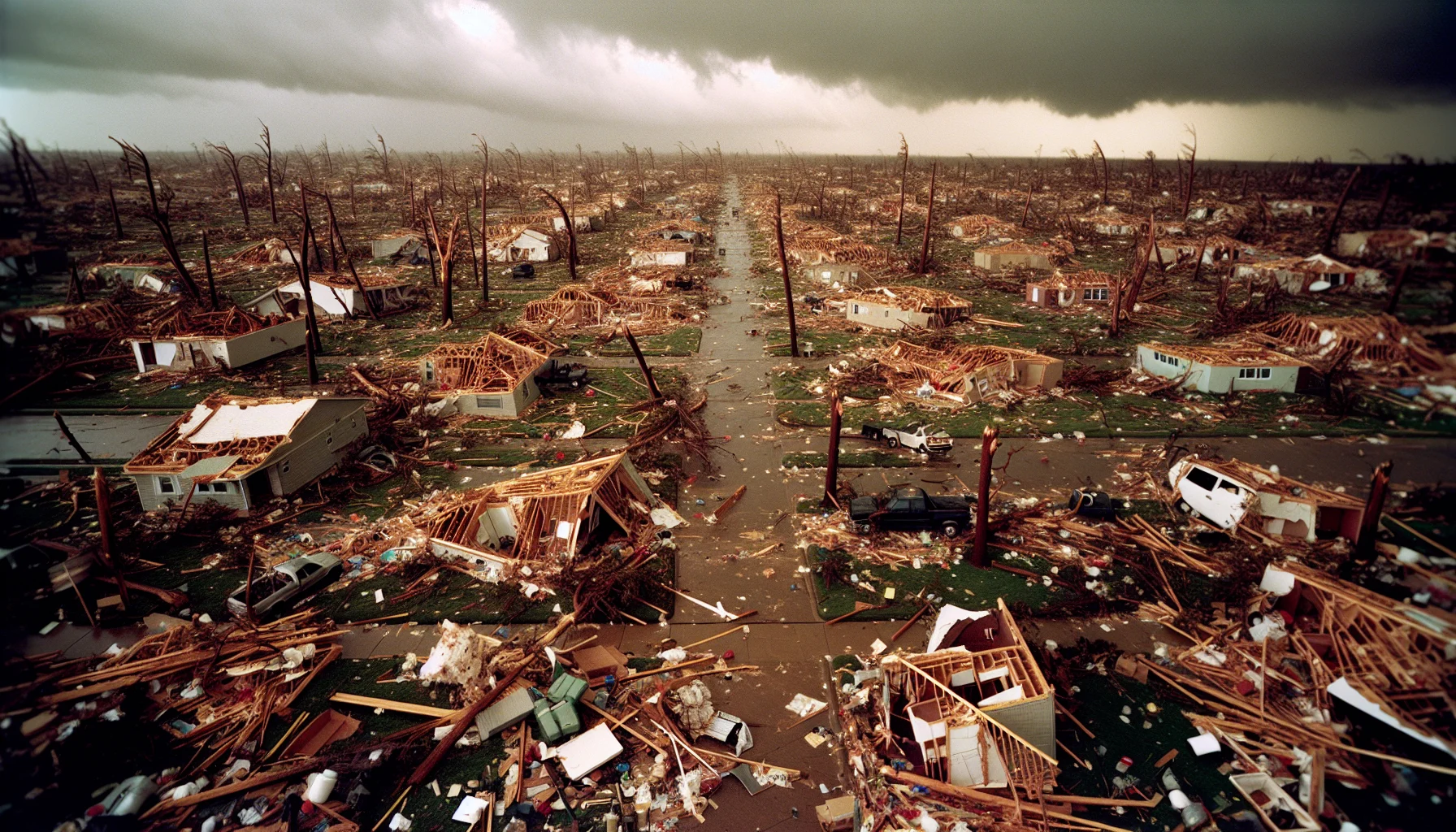
The 1999 Oklahoma Tornado Outbreak
by: The Calamity Calendar Team
May 3, 1999
A Storm Looms
In the spring of 1999, as the sun set gently over the plains of Tornado Alley, the air felt heavy with more than just humidity. It carried whispers of a brewing tempest — a perfect storm rooted deep in the heart of America's most tornado-prone region. This wasn’t just another thunderstorm rumbling through; the seasoned meteorologists at the Storm Prediction Center had a sinking suspicion, built from years of deciphering atmospheric signals, that a significant tornado event was on the horizon. They sensed the kind of atmospheric tango involving low-pressure systems, dry lines, and cold fronts that are the telltale heartbeats of supercells — the fearless progenitors of tornadoes.
Gathering Forces
Tornadoes are no strangers to this part of the world, but the conditions on May 3, 1999, signaled something extraordinary. The air masses collided with a volatile grace, driven by a low-pressure system that knew its role in this dramatic setup. The stage was set across the plains of Oklahoma and Kansas, where cool dry winds from the Rockies met warm moist air from the Gulf of Mexico, igniting a storm system of rare potency. People who lived in this region knew to be wary, and the forecasters were right. What was unfolding in the sky was a recipe for destruction that they knew all too well.
A Force Unleashed
By late afternoon, the skies were boiling with potential. It was 7:00 PM CDT when the sky seemed to lower a smoky, churning mass near Amber, Oklahoma. There, from the blackened clouds, the infamous F5 tornado descended like nature's own hammer of justice — only indiscriminate in its path. The scale and ferocity of what followed were as terrifying as they were mesmerizing.
This tornado, a roaring beast of wind and fury, carved a path across the earth, running northeast with chilling intent. As it bore down on Bridge Creek and then Moore, debris turned the twilight into a swirling vortex of chaos, a scene that seemed to defy reality and surpass nightmares. The devastation across the land became a grim testament to nature's raw power, with homes disintegrating in its path and lives left hanging by the most delicate of threads.
A Harrowing Path
The next day, May 4, 1999, brought some relief as the fury dwindled, with Kansas bearing the lesser brunt of this unleashed rage. By the time the skies finally calmed, more than 70 tornadoes had stampeded across the landscape, leaving a wake of shattered dreams and scarred land in Oklahoma, which accounted for the lion's share of these destructive forces. In mere hours, neighborhoods lay unrecognizable, scenes of once-vibrant communities reduced to a palimpsest of splintered wood and shattered glass.
The human toll was stark and staggering — 36 lives cut short, over 580 souls injured, and families now faced with the unfathomable task of rebuilding their homes, their lives turned inside-out by a force of nature that gave no heed to hope or history. The financial costs, once the dust had settled, skyrocketed past $1 billion, as if any figure could capture the enormity of the loss endured.
Thanks for subscribing!
Rising from the Ruins
In the midst of chaos, the response was swift and almost instinctual. Local heroes in uniforms of all colors, volunteers, and neighbors became the lifeline for survivors. The Red Cross arrived swiftly, casting their net of support, and federal resources, including FEMA, were mobilized, albeit against a devastation that felt almost biblical.
Teams searched tirelessly for survivors amid the debris, guided by compassion and echoes of cries for help buried beneath the rubble. Yet even as they labored in earnest under overcast skies, the calamity of the situation was met with resolve, a stubborn refusal to be beaten down by nature's wrath.
A Legacy of Learning and Change
Out of this catastrophe, hard-learned lessons bore fruit. The need for state-of-the-art warning systems became undeniable, pushing the boundaries of meteorological science to new horizons. Sophisticated radar systems now see potential threats before they unfurl into disaster, and communication protocols were revamped to ensure that no citizen stands unaware when the sirens cry.
Building codes underwent a metamorphosis as well, as safety became central to the way communities planned for their future, mindful of the power hidden in the very skies that daily wander above them.
What We Know Now
The 1999 Oklahoma Tornado Outbreak is a somber, studied chapter now closed in the dusty tomes of storm history. While weather experts pore over the data, what's clear is how this one event reshaped our understanding of what the skies can hold. It kicked open the doors to advancements that today, two decades on, have enhanced predictability and preparedness, saving countless lives.
Yet the reminder remains clear: while technology can provide warnings, it is the ever-ready spirit of communities, and their defiant stand against nature’s tempests, that truly shelters us through these storms. As the people of Oklahoma and Kansas will tell you, you learn to watch the skies and, maybe, even to whisper a prayer into the wind.
Stay in the Loop!
Become a Calamity Insider and get exclusive Calamity Calendar updates delivered straight to your inbox.
Thanks! You're now subscribed.